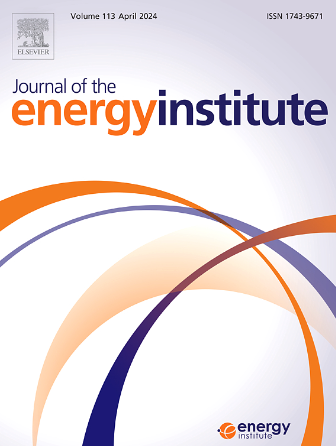Co-production of H2 and CNTs from coal gangue-supported co-pyrolysis of PP/PE/PVC mixture in a two-stage reactor
IF 5.6
2区 工程技术
Q2 ENERGY & FUELS
引用次数: 0
Abstract
As a persistent environmental pollutant, the management of waste plastics is critical for mitigating soil and water contamination. In the quest for carbon neutrality, this study presents a sustainable approach to waste plastic valorization through catalytic pyrolysis, focusing on hydrogen(H2) production and carbon nanotubes (CNTs) synthesis. A coal gangue-based catalyst was utilized in a two-stage fixed-bed reactor for the pyrolysis of polypropylene (PP), polyethylene (PE), and polyvinyl chloride (PVC) to evaluate the co-production efficiency. H2 was yielded by PP and PE at 63.9 vol% and 66.5 vol%, respectively, with PP yielding 6.23 wt% more CNTs than PE. Co-pyrolysis of PP and PE increased H2 concentration by 11.23 vol% and 7.71 vol% over individual pyrolysis, and yields of CNTs by 11.99 wt% and 17.15 wt%, respectively. These results highlight the superiority of mixed pyrolysis over individual processes for H2 concentration and CNTs production. The pyrolysis of PVC, which releases a significant amount of HCl, deactivates a coal gangue-based catalyst that is rich in Fe2O3 and inhibits the growth of CNTs by disrupting the Fe2O3 structure and bonding with carbon. To harness chlorine-containing plastics for CNTs production, the pyrolytic catalytic process must be optimized to mitigate chlorine's detrimental effects. There are valuable insights provided by this research into the thermochemical treatment of waste plastics, contributing to the clean production of H2 and CNTs, aligning with carbon neutrality objectives by reducing reliance on fossil fuels and promoting sustainable waste management strategies.
两级反应器中煤矸石负载共热解PP/PE/PVC混合物制备H2和CNTs的研究
废塑料作为一种持久性的环境污染物,其治理对于缓解土壤和水体污染至关重要。在寻求碳中和的过程中,本研究提出了一种通过催化热解实现废塑料增值的可持续方法,重点关注氢(H2)生产和碳纳米管(CNTs)合成。在两段式固定床反应器中,采用煤矸石基催化剂对聚丙烯(PP)、聚乙烯(PE)和聚氯乙烯(PVC)进行热解反应,考察其联产效率。PP和PE分别以63.9 vol%和66.5 vol%产氢,PP比PE多产6.23 wt%的碳纳米管。与单独热解相比,PP和PE共热解H2浓度分别提高了11.23和7.71 vol%, CNTs的产率分别提高了11.99和17.15 wt%。这些结果突出了混合热解在H2浓度和碳纳米管生成方面的优越性。PVC的热解释放出大量的HCl,使富含Fe2O3的煤矸石基催化剂失活,并通过破坏Fe2O3的结构和与碳的结合来抑制CNTs的生长。为了利用含氯塑料生产碳纳米管,必须优化热解催化过程,以减轻氯的有害影响。本研究为废塑料的热化学处理提供了有价值的见解,有助于H2和碳纳米管的清洁生产,通过减少对化石燃料的依赖和促进可持续废物管理战略,与碳中和目标保持一致。
本文章由计算机程序翻译,如有差异,请以英文原文为准。
求助全文
约1分钟内获得全文
求助全文
来源期刊

Journal of The Energy Institute
工程技术-能源与燃料
CiteScore
10.60
自引率
5.30%
发文量
166
审稿时长
16 days
期刊介绍:
The Journal of the Energy Institute provides peer reviewed coverage of original high quality research on energy, engineering and technology.The coverage is broad and the main areas of interest include:
Combustion engineering and associated technologies; process heating; power generation; engines and propulsion; emissions and environmental pollution control; clean coal technologies; carbon abatement technologies
Emissions and environmental pollution control; safety and hazards;
Clean coal technologies; carbon abatement technologies, including carbon capture and storage, CCS;
Petroleum engineering and fuel quality, including storage and transport
Alternative energy sources; biomass utilisation and biomass conversion technologies; energy from waste, incineration and recycling
Energy conversion, energy recovery and energy efficiency; space heating, fuel cells, heat pumps and cooling systems
Energy storage
The journal''s coverage reflects changes in energy technology that result from the transition to more efficient energy production and end use together with reduced carbon emission.
 求助内容:
求助内容: 应助结果提醒方式:
应助结果提醒方式:


